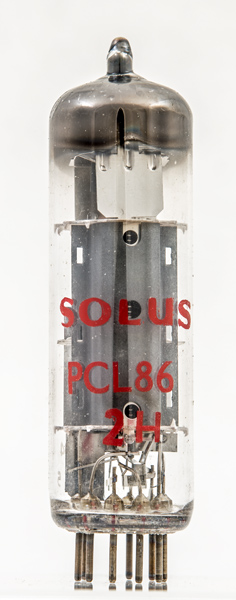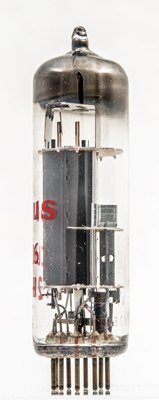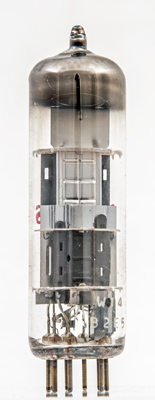|
PCL86Sensibly equivalent¶ to:14GW8See also:
|
|
|

|
The PCL86 was designed for the audio stage of television receivers and offered a quality output. Solus were a retailer not a maker.In 1961 Mullard developed a combination of an ECC83 triode and an EL84 output pentode in a single envelope and this was the ECL86. The PCL86 was the series heater chain version of that work.In a receiver the triode section would provide the first audio amplification, and the output pentode would drive the loudspeaker.The PCL86 as a single ended audio amplifier would have a cathode resistor of 125 Ω and an anode load of 5,100 Ω and under these conditions would produce an output power of 4.1 Watts at a distortion of 10%.
The pentode control grid supports are copper with a radiating fin at the top. The pentode heater wires were formed by coiling the thin tungsten wire and then dissolving away the mandrel. The triode is on the right.
Face view of the triode with the bright screening plate behind and above.The thin glass tube envelope is 20 mm in diameter and, excluding the B9A base pins, is 69 mm tall.References: Data-sheet & 1040. Type PCL86 was first introduced in 1961. See also 1961 adverts. |
Pin Connections
| 1 | 2 | 3 | 4 | 5 | 6 | 7 | 8 | 9 |  g1(t) | k(t) | g2 | h | h | a | k,s,g3 | g1 | a(t) |
|
|
Absolute Maximum Operating Conditions¶
| Vh | Ah | Va | Vs | Vg | mAa | mAs | ra | gm | 
| 13.3 | 0.3 | 230 | 230 | -5.7 | 41.0 | 10.5 | 16,000 | 7.5 |
|
Absolute Maximum Operating Conditions¶
| Vh | Ah | Va | Vg | mAa | ra | gm | 
| 13.3 | 0.3 | 230 | -1.7 | 1.2 | 62,000 | 1.6 |
|
Updated July 21, 2021.
|
|